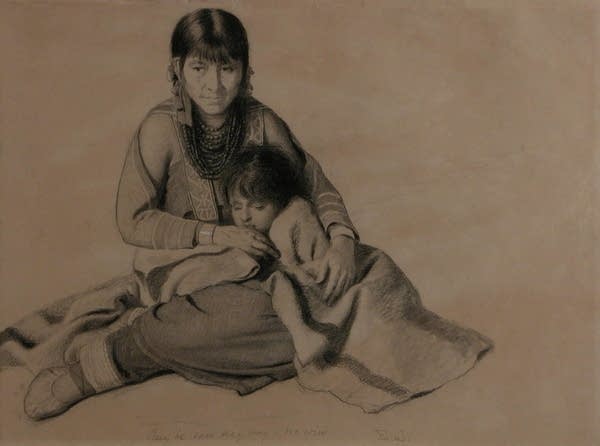Eastman Johnson's legacy in art
Go Deeper.
Create an account or log in to save stories.
Like this?
Thanks for liking this story! We have added it to a list of your favorite stories.

Eastman Johnson was a New Englander who came to the pioneer west to visit his sister and brother. They were both living in Superior in 1856. That was just two years after the Ojibwe of western Lake Superior had signed a treaty giving up large tracts of land for white settlement.
His charcoal drawing of the St. Louis Bay is a study of a special place undergoing rapid change. A steamer churns through the water, and a couple of sailboats scoot by. Several birchbark canoes are pulled up on the sandy shore, where a small group of women are taking in the view. Over it all, puffy clouds balloon in the enormous sky.

Peter Spooner is curator at the Tweed Museum. He says the atmospheric effects are masterful.
"He's really studied how to design the clouds, and use highlights to show the light glinting off the sides of buildings, and the people in the foreground," Spooner says.
Turn Up Your Support
MPR News helps you turn down the noise and build shared understanding. Turn up your support for this public resource and keep trusted journalism accessible to all.
As a young artist, Eastman Johnson had spent the early 1850s studying in Europe. He was beginning to make a name for himself as a portraitist and an Americanist -- a painter who portrayed subjects that were unique to American life. Farm scenes, families at the glowing hearth, children playing on an old stage coach.
In the Tweed exhibit, next to his drawing of the St. Louis Bay is one another one, almost identical. It's by Carl Gawboy, a contemporary Ojibwe artist. He discovered Eastman Johnson's works when he was in high school, and he's been using them as a resource ever since.

Curator Peter Spooner set the two works side by side. In Gawboy's painting, there are two extra characters.
"In Carl Gawboy's version, he has actually placed Eastman Johnson on a tree stump, looking out over the same scene and sketching," Spooner observes. "And one can assume this is his guide, standing nearby, helping him identify the features of the landscape."
Johnson's guide was probably George Bonga, a son of Pierre Bonga, a freed slave. Pierre had married an Ojibwe woman and settled with her people in northern Wisconsin.
Carl Gawboy is convinced spending time with this mixed-race family drew Eastman Johnson into a new reality, which changed his approach to painting.

"Where else would a New Englander ever meet an African American on such intimate terms?" he asks. "And when he went back out east and the abolitionist movement was just starting, he saw something that was really important that he wanted to be a part of -- the humanity of black people. Just as he was able to capture the humanity of Ojibwe people in this part of the country."
Gawboy says Johnson was so friendly with the Bonga family that others in the community were willing to pose for him. Because of that, he was able to create portraits full of detail and feeling.
"I mean obviously these Indians are relaxed, and that's a real important part of his paintings," Gawboy says. "They aren't formal, stiff portraits -- as happened with many photographers at a later time.
One picture shows a group of women gathered on the grass -- the mother nursing a baby in a cradleboard, the older sisters sitting nearby.
Peter Spooner says in Europe, Eastman Johnson's teachers stressed anatomical accuracy. That, and his training as a lithographer, gave his works the detail and power of a master draftsman.

"They have all the fullness and the character of the real human in a real setting. But they also have an intimacy, and a casualness," Spooner says. "And what I love about this particular image is -- it's just a mother and child. And it could be any mother and child, anywhere. It has this incredibly tender quality about it."
Many of the portraits include the name of the subject. That's highly unusual for paintings of Indians at the time. And Carl Gawboy says they're such faithful renderings of real people that he can recognize many of the faces. "I can go to Indian communities today and I see those same faces," he says. "They are our real ancestral portraits because we can still see those faces today."
The exhibit includes portrayals of Ojibwe people by other artists, both Indian and non-Indian. And there are Ojibwe artifacts including beadwork and a cradleboard. It's on view at the Tweed Museum through the end of October.






